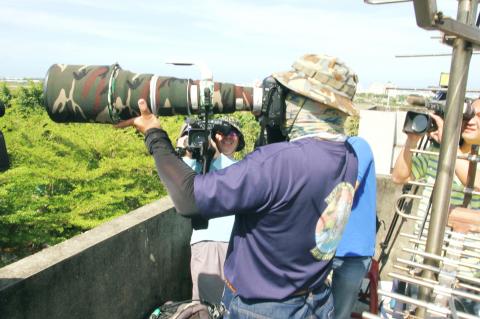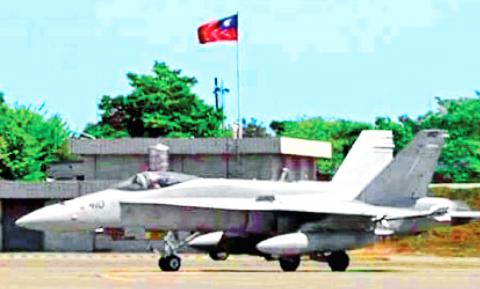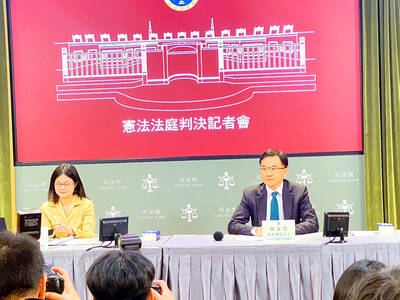A US C-130 transport plane arrived at the Tainan Air Force Base from a US Marine Corps base in Japan yesterday evening, carrying service crew to repair one of the two US F/A-18 jets that made an emergency landing in Tainan on Wednesday.
The repair crew arrived just hours after Chinese Ministry of Foreign Affairs spokeswoman Hua Chunying (華春瑩) told a regular news briefing in Beijing that China had made solemn representations to the US about the US jets landing in Taiwan.
“We demand that the US strictly abide by the one China policy and the three joint communiques between China and the US and to deal with the relevant issue prudently,” she said.

Photo: CNA
Earlier in the day, the two F/A-18s had been moved into hangars belonging to Air Asia Co (亞洲航空), which provides aircraft maintenance, repair and overhaul services at the Tainan Airport.
Meanwhile, US Department of Defense officials confirmed the two F/A-18 Hornets were from US Marine Fighter Attack Squadron 323 (VMFA-323), currently based at Marine Corp Air Station Iwakuni in Yamaguchi Prefecture, Japan.
They said the planes landed in Tainan as a precaution and there had been no injuries to the crew or damage to the aircraft.

Screen grab from the Internet
A statement by the US Marine Corps’ press office late on Wednesday said: “A persistent engine oil pressure warning light precipitated the precautionary emergency landing.”
It also said that the Tainan Airport is an US-approved divert airfield and that the jets had been en route to Singapore to participate in the “Commando Sling” exercise with the city-state’s air force.
However, according to a source in Washington, the F/A-18s were providing escort and protection for a reconnaissance mission by an EA-6B Prowler, a tactical jamming aircraft used by the US Navy and Marine Corps.
An EA-6B Prowler can carry out armed reconnaissance, electronic jamming operations and aerial surveillance tasks, and provides defense against anti-ship missiles.
The Washington source said that due to the sensitivity of its mission, the EA-6B did not land in Tainan with its escort jets, but returned to its base in Japan.
The source said the escort mission took the F/A-18s and the EA-6B on a route along the air defense identification zone over the waters off the east coast of Taiwan and it was headed to either Singapore or the Philippines.
American Institute in Taiwan (AIT) spokesman Mark Zimmer said the US C-130 transport plane, carrying US maintenance personnel and aircraft parts, landed at 8:34pm.
The maintenance crew then headed straight to the hangars to begin repair work.
An AIT team has been sent to Tainan to provide assistance, Zimmer said.
It was not immediately clear how long it would take to repair the aircraft.
A Republic of China Air Force official said the US maintenance crew was expected to stay overnight to carry out the repairs.
The F/A-18s will depart Taiwan as soon as the repairs are completed and the aircraft pass safety tests, the official added.
Air Asia is now owned by Aerospace Corp (台翔航太), but during the Cold War it was an aircraft service unit for Air America, which was created by the CIA for covert operations in East Asia and Southeast Asia.
The company is certified for maintenance and servicing of various aircraft and has links with the US aviation industry, and its location renders the Tainan Airport a US-approved divert air field.
Additional reporting by CNA

The US government has signed defense cooperation agreements with Japan and the Philippines to boost the deterrence capabilities of countries in the first island chain, a report by the National Security Bureau (NSB) showed. The main countries on the first island chain include the two nations and Taiwan. The bureau is to present the report at a meeting of the legislature’s Foreign Affairs and National Defense Committee tomorrow. The US military has deployed Typhon missile systems to Japan’s Yamaguchi Prefecture and Zambales province in the Philippines during their joint military exercises. It has also installed NMESIS anti-ship systems in Japan’s Okinawa

TRAGEDY STRIKES TAIPEI: The suspect died after falling off a building after he threw smoke grenades into Taipei Main Station and went on a killing spree in Zhongshan A 27-year-old suspect allegedly threw smoke grenades in Taipei Main Station and then proceeded to Zhongshan MRT Station in a random killing spree that resulted in the death of the suspect and two other civilians, and seven injured, including one in critical condition, as of press time last night. The suspect, identified as a man surnamed Chang Wen (張文), allegedly began the attack at Taipei Main Station, the Taipei Fire Department said, adding that it received a report at 5:24pm that smoke grenades had been thrown in the station. One man in his 50s was rushed to hospital after a cardiac arrest

ON ALERT: Taiwan’s partners would issue warnings if China attempted to use Interpol to target Taiwanese, and the global body has mechanisms to prevent it, an official said China has stationed two to four people specializing in Taiwan affairs at its embassies in several democratic countries to monitor and harass Taiwanese, actions that the host nations would not tolerate, National Security Bureau (NSB) Director-General Tsai Ming-yen (蔡明彥) said yesterday. Tsai made the comments at a meeting of the legislature’s Foreign Affairs and National Defense Committee, which asked him and Minister of National Defense Wellington Koo (顧立雄) to report on potential conflicts in the Taiwan Strait and military preparedness. Democratic Progressive Party (DPP) Legislator Michelle Lin (林楚茵) expressed concern that Beijing has posted personnel from China’s Taiwan Affairs Office to its

‘ILLEGAL RULING’: The KMT and the TPP slammed the Constitutional Court judgement, saying it contravened the law and was trying to clear the way for a ‘green dictatorship’ The Constitutional Court yesterday ruled that amendments to the Constitutional Court Procedure Act (憲法訴訟法) passed by the Legislative Yuan last year are unconstitutional, as they contravene due legislative process and separation of powers. The Legislative Yuan on Dec. 20 last year passed amendments stipulating that no fewer than 10 grand justices must take part in deliberations of the Constitutional Court, and at least nine grand justices must agree to declare a law unconstitutional. The Executive Yuan on Jan. 2 requested that lawmakers reconsider the bill, but the Legislative Yuan, under a combined majority of Chinese Nationalist Party (KMT) and Taiwan People’s Party